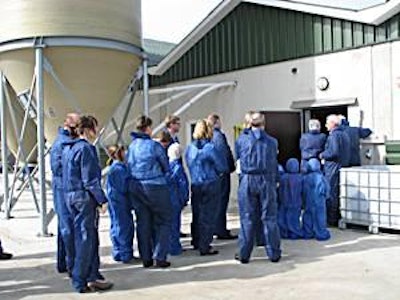
Winning friends and influence – not just the title of a bestselling self-help book, but an important activity for any industry – is sometimes overlooked.
It is sometimes not enough to simply do a good job; you have to let people know about it. How some of Germany’s poultry and egg producers have achieved this, and are continuing to do so, was explained at the International Egg Commission London Conference last year.
Dr. Aline Veauthier, research associate at the University of Vechta, explained how an initiative in Lower Saxony, the center of German poultry production, has not only won over the local population but also resulted in positive press coverage. Following evaluation at the end of 2012, the experimental project will continue through 2013 and be expanded.
Center of production
Located in northwestern Germany, Lower Saxony is home to 54 percent of the country’s broilers, 31 percent of its laying hens and 43 percent of turkey production. In the egg and poultry sectors, all the leading vertically integrated companies have their headquarters there, and average flock sizes are larger than in the rest of the country, with broiler flocks averaging 35,100 head, layer flocks 34,300 head, and turkey flocks comprising an average 12,500 head.
This concentration has led to a number of criticisms being leveled at the industry, including complaints about flock size and flock densities; regional concentration causing air, water and soil contamination; and high levels of antibiotic use.
But are these criticisms valid, and what has the industry done to counter them if they are not justified?
Lower Saxony’s poultry producers tended to take a reactive rather than a proactive stance and had failed to explain, for example, how and why certain forms of housing had been developed and why large flocks were necessary. This had resulted in wider gap between consumer perceptions and the realities and needs of modern poultry production, hence the University of Vechta stepping in to offer a solution.
Working together
Working with producers, the university was able to identify what were the major issues facing the industry. Together, a strategy was elaborated to inform the public about modern poultry meat and egg production methods. This included opening up houses to the public, and three test farms were selected.
In addition, it was decided to run an information campaign focusing on the quality and safety of affordable poultry products. Once finance for the project was secured, and farmers found who were willing to open their farms to the public, briefings were carried out to prepare producers to receive visitors. Few concerns were expressed by the region’s producers prior to the openings and 60 farmers were willing to take part. Six were selected to open their farm gates to the public. The main concern was would anyone actually come!
The strategy was tested on broiler, turkey and egg farms with flocks of various sizes. In August, a press conference was held, followed by farm visits which included discussions with farmers, the Lower Saxony Poultry Association and representatives of the project. Topics covered included modern production systems, housing systems, flock sizes, costs and profits, disease, vaccination and treatment, animal welfare and environmental issue, and the steps that have been taken to address these.
Ongoing dialogue
Following the farm visits, reports began to appear on television and in newspapers and magazines. Most were highly positive, although there was some criticism.
Since September 2012, there have been two open houses, with broiler, layer and turkey farms opening their doors to the public. Those farms opening to visitors have been announced in the media.
At the first farm visit in September, 600 visitors were counted; at the October sessions, the number of visitors reached 750 across three farms. In some ways, the October openings were easier than those of September, given that it was possible to gauge interest beforehand. A lot of families visited the farms, with children being allowed to go inside the poultry houses.
The openings were a success for all concerned. Feedback from farmers was that the open houses had been a great experience and should be repeated. Interviews with visitors conducted by the university showed there was genuine interest in seeing how birds are a kept and a desire to learn more. There was also positive feedback regarding the opportunities to meet and talk to farmers. For many, this was the first time that they visited a farm or met a farmer!
Most visitors changed their mind about poultry and egg production and now believe that birds are kept in good conditions and are well cared for by their owners, with many wanting to know where they could buy the produce from the farms that they had visited, demonstrating the establishment of trust.
The end of the 2012 saw a review of the project and, in light of the positive feedback, more openings are planned between March and September this year. Six farmers opened their doors to the public in 2012 across two open farm days and, given the success of the project, it expected that more will enroll this year.


















